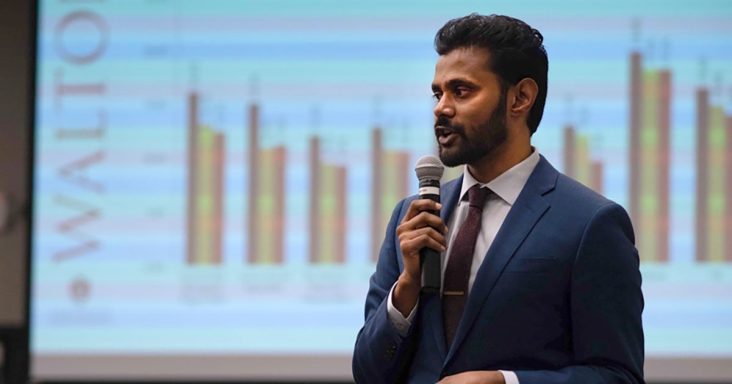UA economist provides positive outlook for Northwest Arkansas
by October 25, 2023 5:08 pm 2,097 views

University of Arkansas economist Mervin Jebaraj.
A University of Arkansas economist painted a rosy picture of the Northwest Arkansas economy amid expectations of strong U.S. GDP growth, ranging between 3% and 4% in the third quarter. The Bureau of Economic Analysis will post third-quarter GDP data on Thursday (Oct. 26).
Economist Mervin Jebaraj presented the GDP projection and other economic data during a business analysis luncheon on Wednesday (Oct. 25) in Fayetteville.
Jebaraj said he expects about 4% growth but wouldn’t be shocked to see 5% growth in the third quarter. Before the COVID-19 pandemic, the long-term average GDP growth rate was about 2.1%. The second-quarter GDP growth rate was 2.1%.
“We’re not in a recession because…consumers are going out and spending money (and) the unemployment rates are low across the board,” he said. “You ask, ‘How low is it?’ Well, to be fair, I think even the unemployment benefits office has a help wanted sign on it today.”
The Center for Business and Economic Research (CBER) in the Sam M. Walton College of Business at the UA, in collaboration with the Northwest Arkansas Council, released the annual State of the Northwest Arkansas Region Report on Wednesday at the Fayetteville Town Center. Jebaraj, who’s director of the Center for Business and Economic Research, also provided economic data from CBER’s Quarterly Business Analysis.
Asked what letter grade he’d give the Northwest Arkansas economy, Jebaraj said “solid B+” when compared to peer regions. Asked when the next recession might be, Jebaraj said if he were to guess, the soonest one could happen would be in the second half of 2024. “We don’t have to have a recession,” he added.
Donna Morris, executive vice president and chief people officer for Walmart Inc., was guest speaker at the luncheon. She responded to questions from Nelson Peacock, president and CEO of the Northwest Arkansas Council.
Morris, who is on the council’s executive committee, said the region’s “amazing growth” in jobs stood out to her in the State of the Northwest Arkansas Region Report. The annual report compares Northwest Arkansas to six peer regions or regions that are typically much larger than Northwest Arkansas and some of the fastest growing in the United States.
Northwest Arkansas ranked second with 11.2% in nonfarm employment growth from 2020 and 2022, the report shows. Only the Austin, Texas, metro had higher growth at 16.7% over the period.
Jebaraj said almost everyone who can work is working in Northwest Arkansas, and employers are still struggling to hire. But he noted this has eased some from 2022. Since the start of the pandemic, Northwest Arkansas has added 35,000 jobs. Over the same period, Arkansas added about 70,000.
More than 575,000 people live in Northwest Arkansas, he said. The region is adding about 13,000 people annually. According to the report, Northwest Arkansas’ 4.9% population growth from 2020 to 2022 ranks third compared to the peer regions, behind the Austin metro (5.3%) and Provo-Orem, Utah, metro (5.9%).
However, Morris was concerned about the rising airfares noted in the report and encouraged airport officials in the room to attract more affordable airlines. The report compares economic data in 2022 to previous years. According to the report, airfares have risen by 33.5% to $499 in 2022 from $374 in 2020.
Asked why airfares rose, Aaron Burkes, CEO of Northwest Arkansas National Airport (XNA), said airfares have declined over the past year. He added that the airfares will be higher when compared to other airports because a large percentage of XNA’s passengers are business travelers. Business travelers often book flights shortly before departure when airfares are higher, driving up the average price.
Burkes said XNA officials meet regularly with low-cost carriers asking them to either start service here or expand flights to new destinations. He noted most low-cost carriers are focused on leisure, not business destinations. As a result, carriers offering business destination routes likely won’t face new competition, which could drive down airfares.
Morris also discussed the importance of home affordability, public transportation and Walmart’s new Home Office that’s under construction.
“It will start next year opening with the Walton Whole Health Fitness Center,” she said. “This is something like you’ve never seen before, and it will be available to our associates and their family members.”
She also said “downtown section” of the new Home Office will be open to the public, comprising food, activities and stores. There will also be a Walmart Welcome Center and a daycare, opening in mid-2024.
Another topic that both Peacock and Jebaraj noted in their presentations was commute time. Peacock said it’s a metric he’s interested in tracking as the region grows and wants to see how this affects the region’s quality of life.
Jebaraj said the metric coordinates with a region’s office vacancy rate. Higher commute times correlate with higher office vacancy rates.
